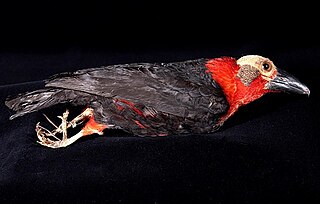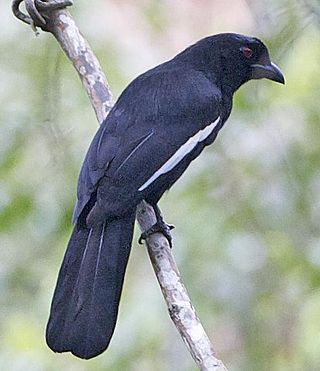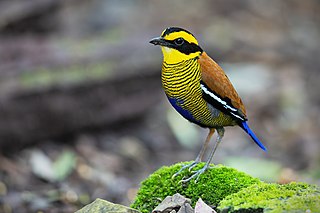
The forktails are small insectivorous birds in the genus Enicurus. They were formerly placed in the thrush family, Turdidae, but are now treated as part of the Old World flycatcher family, Muscicapidae. Their common name derives from their long forked tail.

The Bornean bristlehead, also variously known as the bristled shrike, bald-headed crow or the bald-headed wood-shrike, is the only member of the passerine family Pityriasidae and genus Pityriasis. This enigmatic and vulnerable species is endemic to the southeast Asian island of Borneo, where it lives in small groups in the rainforest canopy.

The Bornean peacock-pheasant is a medium-sized pheasant. It is probably the rarest and certainly the least known of all peacock-pheasants. This elusive bird is endemic to lowland forests of Borneo.

The Bornean crested fireback is a medium-sized forest pheasant from Borneo and the Bangka Belitung Islands. It is the type species of the genus Lophura. Prior to 2023, it was referred to as simply the crested fireback as the Malayan crested fireback was lumped with this species, though both have since been split.

The red-breasted partridge, also known as the Bornean hill-partridge, is a species of bird in the family Phasianidae. It is endemic to hill and montane forest in Borneo, preferring bamboos and thickets. The International Union for Conservation of Nature (IUCN) has assessed it as a least-concern species.

The black-backed forktail, occasionally referred to as the black-throated forktail, is a forktail species in the family Muscicapidae. The species was described in 1836, from a specimen collected in Nepal. It is a medium-sized forktail, weighing between 25 and 29 grams, with a length of 20.5 to 23 centimetres. The species has a broad white stripe across its forehead. The crown, face, and mantle are black, while the bird's underparts are white, sharply divided from the black above. The wings are largely black with a broad white stripe across the greater coverts. The tail of the species, similar to that of other forktails, is long, graduated, and deeply forked. The tail is black with a white tip and three white bands created by shorter tail feathers. The beak of the bird is black, while the feet and legs are light pink, and the iris is brown. The species is monomorphic.

The white-crowned forktail is a species of forktail in the family Muscicapidae. Formally described in 1818, it has five subspecies, each occupying a different geographic range. The largest of the forktails, Enicurus leschenaulti, is between 25 and 28 centimetres long. It has a black throat and breast, black mantle, and largely black wings. The rump and lower back are white, and the bird has a prominent white crown, from which it gets its name. As with other forktails, the tail is long, deeply forked, and banded in black and white. A variety of whistling and clicking calls have been described. Slight morphological differences have been observed between subspecies.

The spotted forktail is a species of bird in the family Muscicapidae. It is found in the Himalayas and the hills of Northeast India, Bangladesh, Myanmar, and southern China including Yunnan. Birds of this species are 25 cm with a long tail. The sexes are alike, having a white forehead and a black crown and nape, a black back spotted white, and a broad white wing bar. The tail is deeply forked, graduated black and white. The white spotted back easily identifies this species from other similar sized forktail. Its call is a shrill, screechy KREE, mostly given in flight; it also makes some shrill, squeaky notes while perched. It breeds mostly at 1200–3600 m, and descends to about 600 m in winter. Its natural habitat is subtropical or tropical moist montane forests, where it is found in boulder-strewn torrents, forest streams, and roadside canals.

The chestnut-naped forktail is a species of bird in the flycatcher and chat family Muscicapidae. The species is monotypic, having no subspecies. It is found in Sundaland, in southern Burma and Thailand to Peninsular Malaysia, as well as Sumatra and Borneo. The species is not migratory.

The slaty-backed forktail is a species of forktail in the family Muscicapidae. A slim, medium-sized forktail, it is distinguished from similar species by its slate grey forehead, crown, and mantle. It has a long and deeply forked tail banded in black and white, a white rump, and a white bar across its primary feathers; the rest of the plumage is predominantly white. The sexes look alike. The bird frequents the edges of fast-flowing streams and rivers, where it hunts small invertebrates by hopping among rocks or flying out over the water. It breeds between February and July, laying 3–4 pinkish, bluish, or white eggs; both sexes incubate the eggs.

The Sunda forktail is a species of bird in the family Muscicapidae. It is endemic to Indonesia, where it is restricted to the islands of Java and Sumatra. Its natural habitat is boulder strewn streams in tropical moist montane forest from 600–2000 m. More rarely the species occurs closer to sea level. The species is common in Sumatra, but is rarer in Java, where the white-crowned forktail is more common.

The blue-headed pitta is a species of bird in the pitta family Pittidae. It is endemic to Borneo.

The Malayan black magpie is a species of bird in the family Corvidae. Despite its name, it is neither a magpie nor, as was long believed, a jay, but a treepie. Treepies are a distinct group of corvids externally similar to magpies.

The Bornean treepie is a passerine bird belonging to the treepies genus, Dendrocitta, of in the crow family, Corvidae. It is endemic to the island of Borneo. It is sometimes treated as a subspecies of the Sumatran treepie.

The Bornean bulbul is a member of the bulbul family of passerine birds. It is endemic to the island of Borneo.

The white-crowned shama is a bird in the Old World flycatcher family. It is endemic to the Southeast Asian island of Borneo.

The Bornean banded pitta is a species of bird in the family Pittidae. It is found only in Borneo. It was formerly considered conspecific with the Javan and Malayan banded pittas. Together, they were referenced as the banded pitta.

The Bornean black magpie, also known as the black crested magpie, is a treepie in the family Corvidae. It is endemic to the Southeast Asian island of Borneo.


















